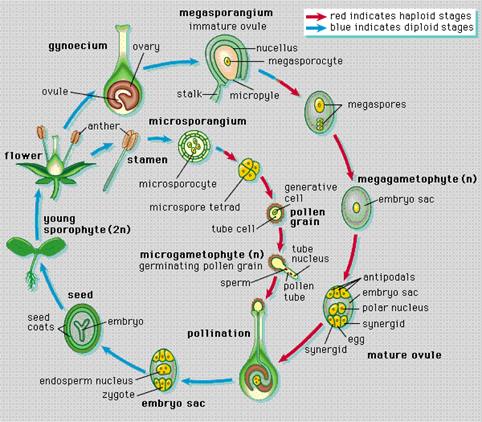Reproduction
Like all land plants, the life cycle of Linum marginale is through a cycle called alternation of generations meaning the multicellular haploid and diploid stages alternate. In the anthers, within a dominant sporophyte (the part of the plant one sees), diploid spores called microsporophytes are produced. They then go through meiosis, a process of cell division resulting in half of the amount of chromosomes producing haploid microspores. Next, these microspores go through mitotic division, a nuclear division in which the nucleus divides and creates two new nuclei with a complete copy of the parental chromosomes. They differentiate to produce pollen grains which make up the male gametophyte. Similarly, a process occurs within the flowers female parts-a single carpel consists of a stigma, style, ovary, and ovule. A diploid megasporocyte exists in the ovule, which is found within the ovary; the megasporocyte divides by meiosis to produce four haploid megaspores, only one of which survives. The surviving megaspore goes through mitosis to produce seven haploid cells. These seven cells form into the female gametophyte. The female and male gametophytes are located within the hermaphrodite flowers, meaning the flower produces both male and female gametes. The female and male gametes go through fertilization and form into a zygote; the pollen grain travels, by way of insects through the pollen tube and enters the female gametophyte. One sperm fertilizes the egg forming the zygote and the other fertilizes the two polar nuclei, forming a triploid cell. The developing zygote, which develops into an embryo, the triploid endosperm, which provides food for the embryo, and the seed coat are all part of the seed. This seed then germinates and forms into the next dominant sporophyte (Campbell et al, 2008).
The seeds are oval in shape, flat, and have a glossy brown color. The fruit is a pale brown papery capsule which contains ten different segments, each only containing one seed. The flowers are light blue in color and have darker veins with white stamen. The flowers are 5-petalled and held together in a terminal cluster. Flowering occurs most of the year, peaking from spring to late summer (The Royal Botanic Gardens and Domain Trust).

Continue onto Interactions
Go Home
